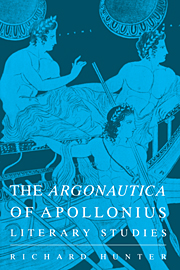Book contents
- Frontmatter
- Contents
- Preface
- List of abbreviations
- 1 Introduction
- 2 Modes of heroism
- 3 Images of love
- 4 The gods and the divine
- 5 The poet and his poem
- 6 The Argonautica and its Ptolemaic context
- 7 Argonautica and Aeneid
- Appendix: ἓν ἂισμα διηνκές: Aristotle, Callimachus, Apollonius
- Bibliography
- General index
- Index of passages discussed
- Frontmatter
- Contents
- Preface
- List of abbreviations
- 1 Introduction
- 2 Modes of heroism
- 3 Images of love
- 4 The gods and the divine
- 5 The poet and his poem
- 6 The Argonautica and its Ptolemaic context
- 7 Argonautica and Aeneid
- Appendix: ἓν ἂισμα διηνκές: Aristotle, Callimachus, Apollonius
- Bibliography
- General index
- Index of passages discussed
Summary
In giving eros a central role in his epic, Apollonius was not innovating radically in perceptions of the epic tradition: Calypso and Nausicaa were for later antiquity ‘classic’ erotic paradigms, and the relationship of Achilles and Patroclus was after Homer regularly understood as an erotic one. Moreover, the portrayal in literature of those affected by erotic desire had a very long history. Sappho had created a representation of female desire which was to be revalidated by echo throughout antiquity, and the vocabulary and imagery of erotic suffering was already fully developed in the poetry of the archaic period. Attic tragedy also was clearly an important forerunner: even from our small number of surviving plays we can see that Apollonius' Medea owes a debt not merely to her tragic namesake, but also to Euripides' Phaedra, who provided a crucial model of a woman seeking to fight against a desire which she knows to be wrong. From New Comedy, to which it is often claimed Apollonius, in Book 3 particularly, owed much, less seems in fact to have been drawn. In the plays of Menander which survive at all extensively in Greek it is male desire and the effect of eros on men that is regularly cited and which has an important plot function.
- Type
- Chapter
- Information
- The Argonautica of Apollonius , pp. 46 - 74Publisher: Cambridge University PressPrint publication year: 1993



